Depth Model and 5-Axis Variable-Angle Laser Engraving Experiment Based on the Energy Conservation Principle
Abstract
1. Introduction
2. Materials and Methods
2.1. Experimental Equipment
2.2. Orthogonal Test Design of Laser Engraving
2.3. Laser Power Adjustment of the 5-Axis Variable-Angle Laser Engraving Process
3. Depth Model of 5-Axis Variable-Angle Laser Engraving
3.1. Depth Model of 5-Axis Variable-Angle Laser Engraving Based on the Energy Conservation Principle
3.2. Identification of the Depth Model Parameters
4. Results and Discussions
4.1. Results of the Orthogonal Test
4.2. Laser Adjustment Results of the Variable-Angle Straight Groove Engraving
5. Conclusions
Author Contributions
Funding
Institutional Review Board Statement
Informed Consent Statement
Data Availability Statement
Acknowledgments
Conflicts of Interest
References
- Hansen, J.O.; Long, K.C.; Jackson, M.A.; Hodgens, H.M. Chemical Milling Process and Solution for Cast Titanium Alloys. U.S. Patent No. 6,793,838, 21 September 2004. [Google Scholar]
- Hot, J.; Dasque, A.; Topalov, J.; Mazars, V.; Ringot, E. Titanium valorization: From chemical milling baths to air depollution applications. J. Clean. Prod. 2020, 249, 119344. [Google Scholar] [CrossRef]
- Mahamood, R.M.; Akinlabi, E.T. Chemical Cutting Process. In Advanced Noncontact Cutting and Joining Technologies; Springer: Berlin/Heidelberg, Germany, 2018; pp. 11–25. [Google Scholar]
- Ezugwu, E.O.; Bonney, J.; Yamane, Y. An overview of the machinability of aeroengine alloys. J. Mater. Process. Technol. 2003, 134, 233–253. [Google Scholar] [CrossRef]
- Gnanamuthu, D.S.; Moores, R.J.; Paton, N.E.; Vyhna, R.F. Non-Contact Scribing Process for Organic Maskants on Metals or Alloys Thereof. U.S. Patent US 4,716,270, 29 December 1987. [Google Scholar]
- Slysh, P. Laser Assisted Masking Process. U.S. Patent US 5,147,680, 5 September 1992. [Google Scholar]
- GRIFFIN, B.M. Aluminum Chemical Milling. 2003, p. 1159. Available online: https://www.academia.edu/download/45969448/Handbook-of-Aluminum.pdf#page=1172 (accessed on 1 February 2022).
- Leone, C.; Lopresto, V.; Minutolo, F.M.C.; De Iorio, I.; Rinaldi, N. Laser ablation of maskant used in chemical milling process for aerospace applications. In Proceedings of the XVIII International Symposium on Gas Flow, Chemical Lasers, and High-Power Lasers, Sofia, Bulgaria, 30 August–3 September 2010; p. 77511M. [Google Scholar]
- Gao, X.J.; Huang, Q.-S.; Liu, B.-Q.; QIU, Z.-F.; Kan, T. Research on Application of Three Dimensional Laser Cutting Technique in Chemical Milling and Welding Case. Mach. Des. Manuf. 2012, 7, 92–94. [Google Scholar] [CrossRef]
- LiYan, P.; Hui, W.; PengPeng, S.; Jian, W. Study on Laser Engraving Process Parameters of Protective Coatings on Titanium Alloy Substrate for Chemical Milling. Plat. Finish. 2021, 43, 29–35. [Google Scholar]
- Yin, Z.; Liu, Q.; Sun, P.; Ding, J. Kinematic Analysis and Parameter Measurement for Multi-Axis Laser Engraving Machine Tools. Machines 2021, 9, 237. [Google Scholar] [CrossRef]
- Wang, J.; Liu, Q.; Sun, P.; Ning, Z.; Wang, L. Study on Model and Experimental of Laser Scribing Parameter of Maskant in Chemical Milling for Aerospace Applications. Appl Sci. 2022, 12, 2914. [Google Scholar] [CrossRef]
- Arnold, N.; Bityurin, N.; Bauerle, D. Laser-induced thermal degradation and ablation of polymers: Bulk model. Appl. Surf. Sci. 1999, 138, 212–217. [Google Scholar] [CrossRef]
- Prakash, S.; Kumar, S. Profile and depth prediction in single-pass and two-pass CO2 laser microchanneling processes. J Micromech. Microeng. 2015, 25, 035010. [Google Scholar] [CrossRef]
- Shahbazi, A.; Koohian, A.; Madanipour, K. Effect of scanning speed on continuous wave laser scribing of metal thin films: Theory and experiment. Laser Phys. 2017, 27, 016101. [Google Scholar] [CrossRef]
- Zhao, K.; Jia, Z.Y.; Ma, J.W.; Liu, W.; Wang, L. Nanosecond multi-pulse laser milling for certain area removal of metal coating on plastics surface. Opt. Lasers Eng. 2014, 63, 58–69. [Google Scholar] [CrossRef]
- Nakamura, S.; Midorikawa, K.; Kumagai, H.; Obara, M.; Toyoda, K. Effect of pulse duration on ablation characteristics of tetrafluoroethylene-hexafluoropropylene copolymer film using Ti: Sapphire laser. Jpn. J. Appl. Phys. 1996, 35, 101. [Google Scholar] [CrossRef]
- Antończak, A.J.; Nowak, M.; Szustakiewicz, K.; Pigłowski, J.; Abramski, K.M. The influence of organobentonite clay on CO2 laser grooving of nylon 6 composites. Int. J. Adv. Manuf. Technol. 2013, 69, 1389–1401. [Google Scholar] [CrossRef]
- Pazokian, H. Theoretical and experimental investigations of the influence of overlap between the laser beam tracks on channel profile and morphology in pulsed laser machining of polymers. Optik 2018, 171, 431–436. [Google Scholar] [CrossRef]
- Bovatsek, J.M.; Patel, R.S. Highest-speed dicing of thin silicon wafers with nanosecond-pulse 355nm q-switched laser source using line-focus fluence optimization technique. In Proceedings of the Laser-Based Micro-and Nanopackaging and Assembly Iv, San Francisco, CA, USA, 26–28 January 2010; Pfleging, W., Lu, Y., Washio, K., Amako, J., Hoving, W., Eds.; SPIE: Bellingham, WA, USA, 2010; Volume 7585. [Google Scholar] [CrossRef]
- Jia, Z.; Zhao, K.; Liu, W.; Ma, J.; Wang, L. Nanosecond pulsed laser processing circuits on the copper clad polyimide. Int. J. Mach. Mach. Mater. 2014, 15, 157–173. [Google Scholar] [CrossRef]
- Xiaowei, B.; Meng, C.; Gang, L. Study on Machining of Sapphire by 355 nm Nanosecond and 1064 nm Picosecond Laser. Laser Optoelectron. Prog. 2016, 53, 51404. [Google Scholar] [CrossRef]
- Ai, J.; Xiang, H.Q.; Du, Q.F.; Chen, D.C.; Liu, J.G.; Zeng, X.Y. Rapid and high-performance processing technology for large-area frequency selective surfaces. J. Mater. Process. Technol. 2019, 264, 129–133. [Google Scholar] [CrossRef]
- Desai, C.K.; Shaikh, A. Prediction of depth of cut for single-pass laser micro-milling process using semi-analytical, ANN and GP approaches. Int. J. Adv. Manuf. Technol. 2012, 60, 865–882. [Google Scholar] [CrossRef]
- Nukman, Y.; Hassan, M.A.; Harizam, M.Z. Optimization of Prediction Error in CO2 Laser Cutting process by Taguchi Artificial Neural Network Hybrid with Genetic algorithm. Appl. Math. Inf. Sci. 2013, 7, 363–370. [Google Scholar] [CrossRef]
- Yin, Z.; Liu, Q.; Sun, P.; Wang, J. Study on Nanosecond Laser Ablation of 40Cr13 Die Steel Based on ANOVA and BP Neural Network. Appl. Sci. 2021, 11, 10331. [Google Scholar] [CrossRef]
- Smokvina Hanza, S.; Marohnić, T.; Iljkić, D.; Basan, R. Artificial Neural Networks-Based Prediction of Hardness of Low-Alloy Steels Using Specific Jominy Distance. Metals 2021, 11, 714. [Google Scholar] [CrossRef]
- Hossain, A.; Hossain, A.; Nukman, Y.; Hassan, M.A.; Harizam, M.Z.; Sifullah, A.M.; Parandoush, P. A Fuzzy Logic-Based Prediction Model for Kerf Width in Laser Beam Machining. Mater. Manuf. Process. 2016, 31, 679–684. [Google Scholar] [CrossRef]
- Juez-Gil, M.; Erdakov, I.N.; Bustillo, A.; Pimenov, D.Y. A regression-tree multilayer-perceptron hybrid strategy for the prediction of ore crushing-plate lifetimes. J. Adv. Res. 2019, 18, 173–184. [Google Scholar] [CrossRef] [PubMed]
- Reinhart Poprawe. Tailored Light 2: Laser Application Technology; Springer: Berlin/Heidelberg, Germany, 2016; pp. 410–429. [Google Scholar]
- Dubey, A.K.; Yadava, V. Laser beam machining—A review. Int. J. Mach. Tools Manuf. 2008, 48, 609–628. [Google Scholar] [CrossRef]


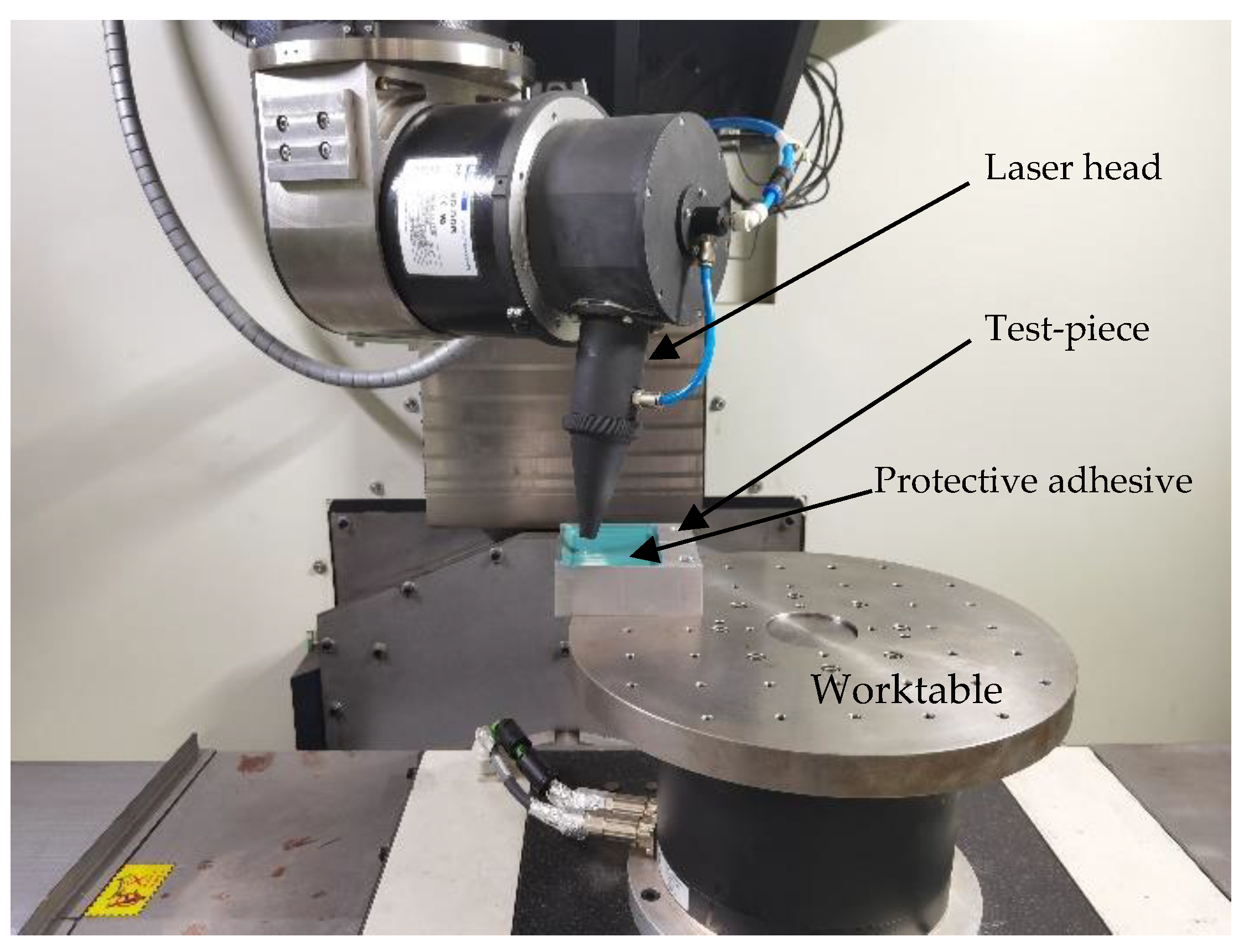
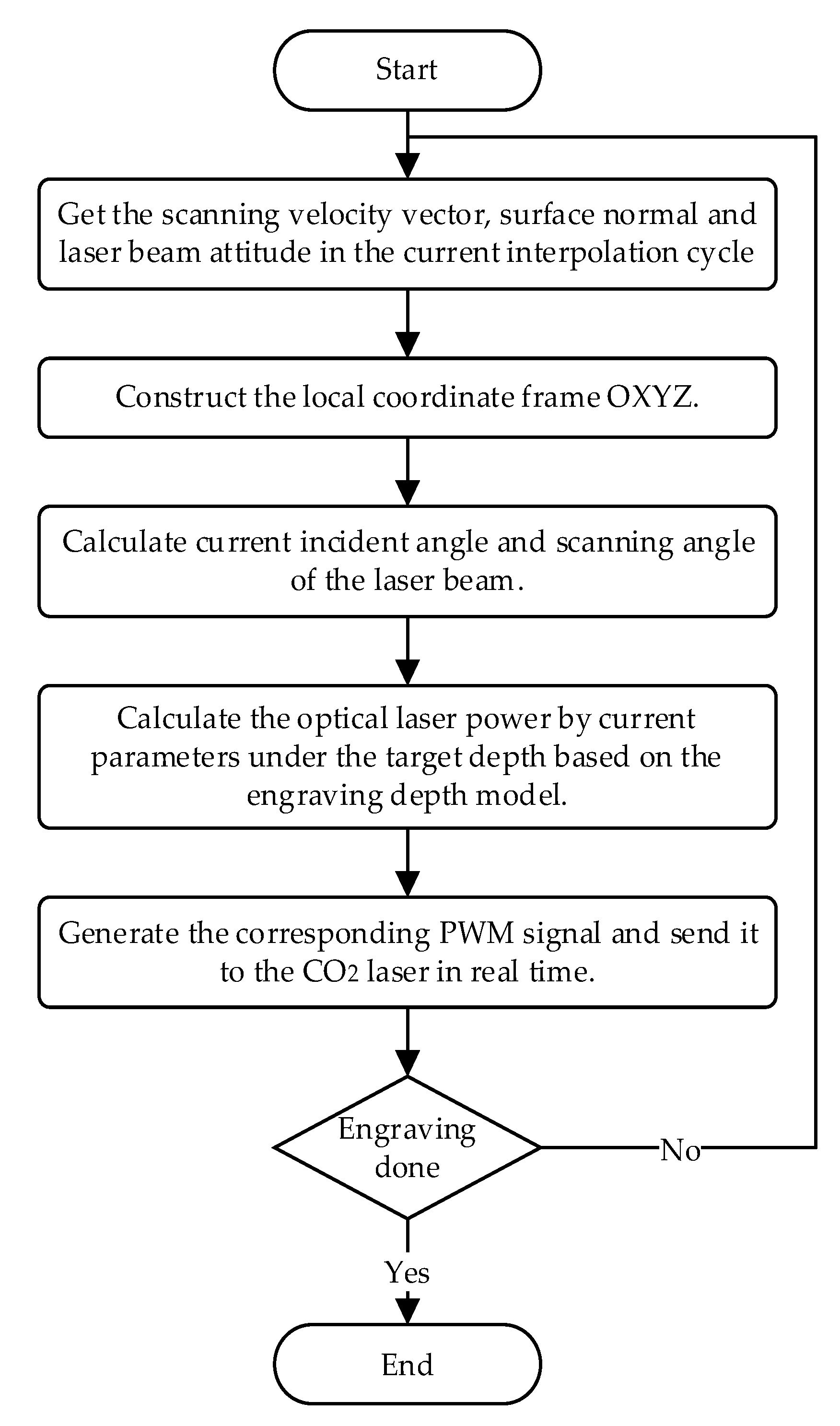
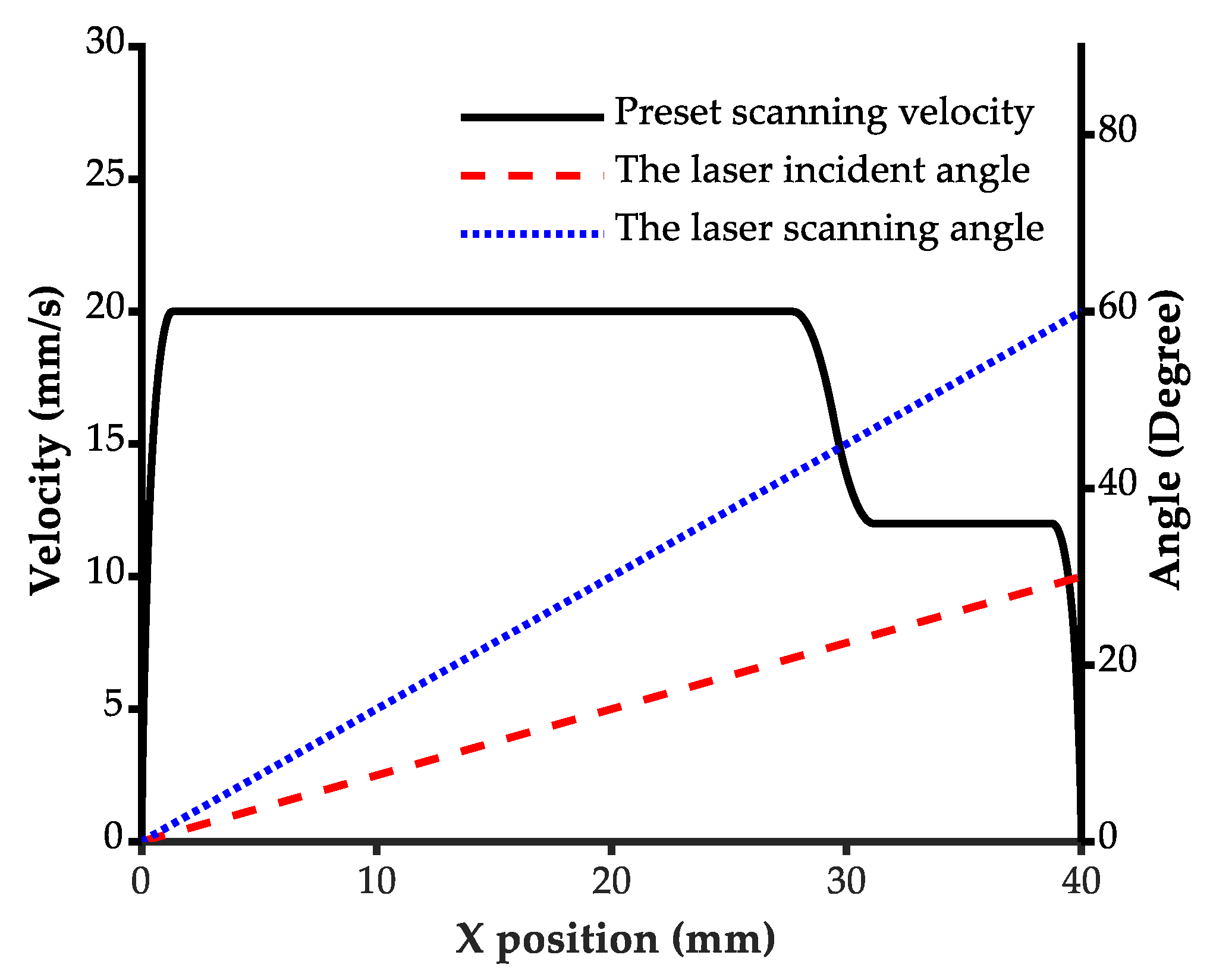


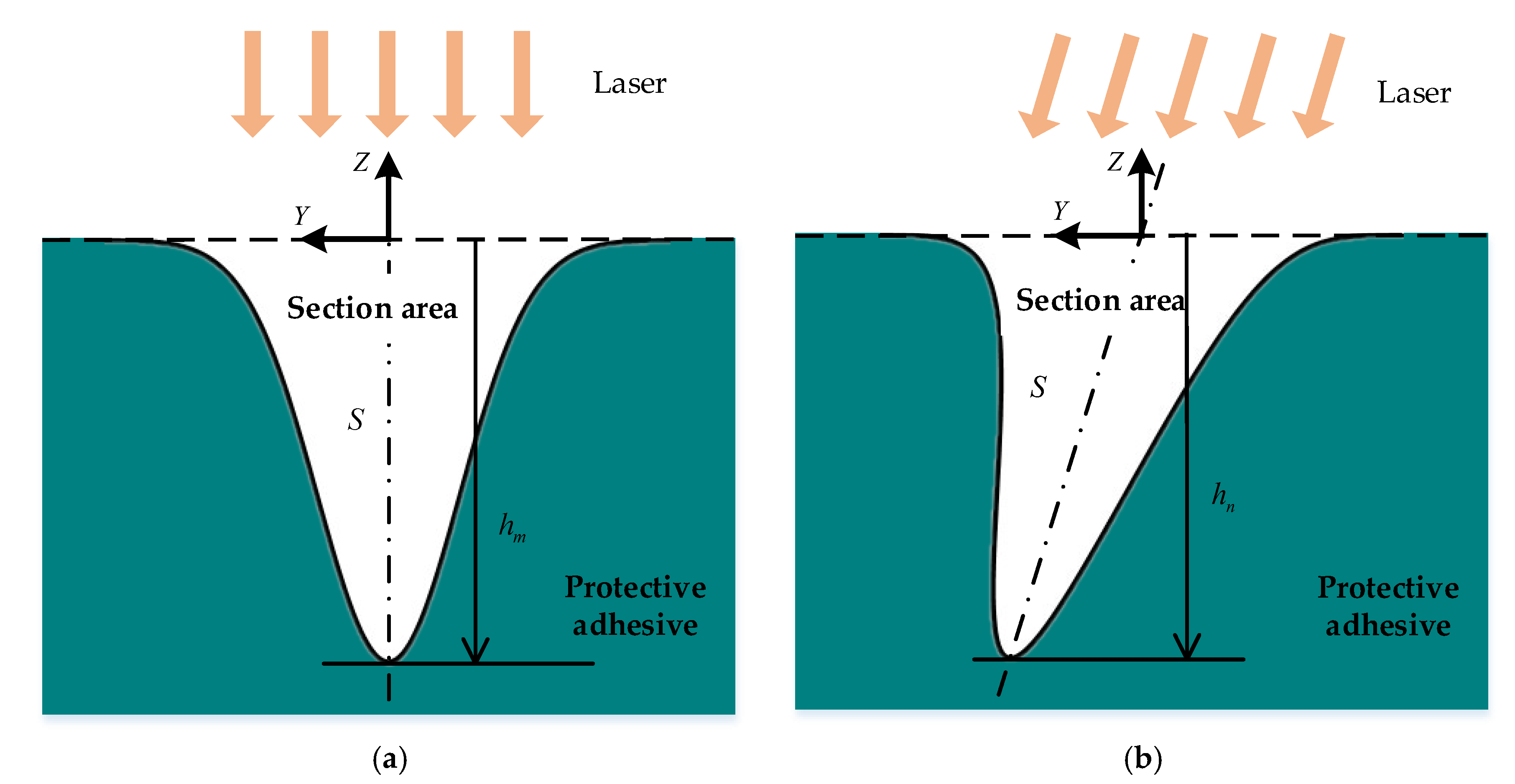
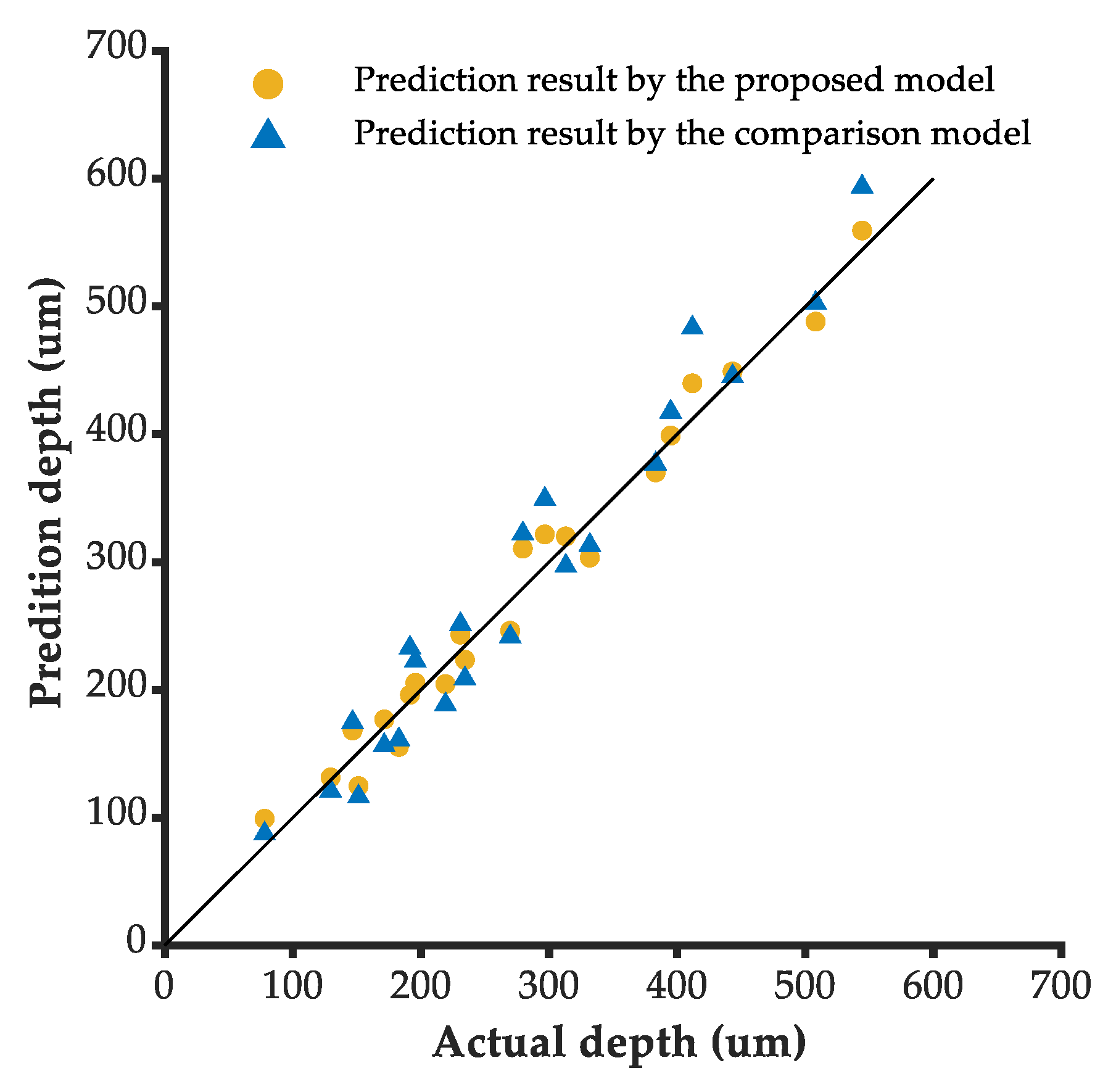
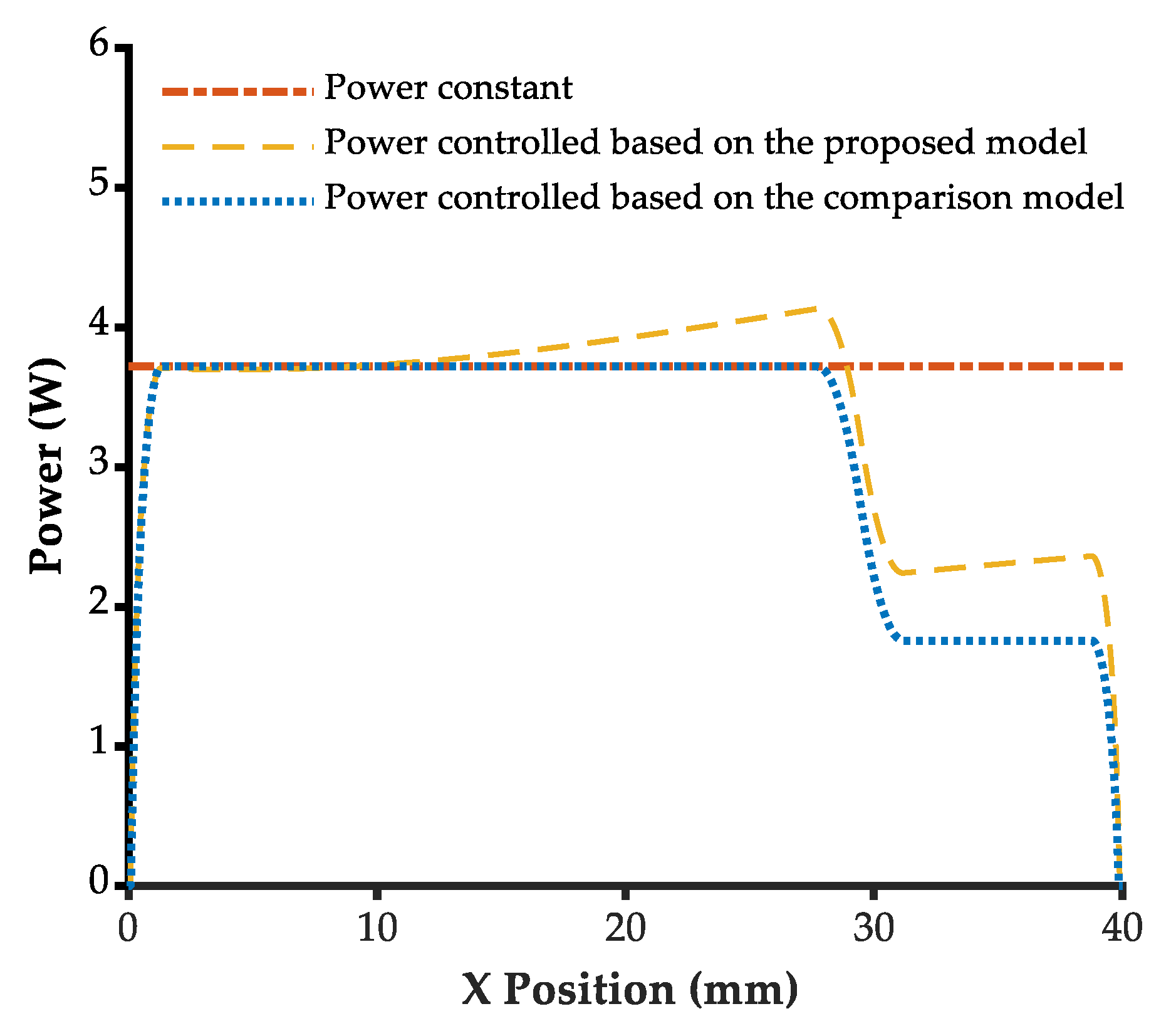

| Method | Scholars | Research Content |
|---|---|---|
| The engraving depth model based on the laser ablation mechanism | Arnold, N et al. [13] | Established the relationship between laser ablation depth and laser energy density of polymer materials based on the photothermal melting zone fracture theory. |
| Prakash, S. et al. [14], Shahbazi et al. [15], Zhao, K. et al. [16] | Studied the correlation among multi-pulse laser ablation depth, laser energy, and feed-rate through the superposition of multi-pulse laser ablation depth based on the principle of energy balance. | |
| Nakamura S et al. [17], Arkadiusz A.J [18], Pazokian H [19] | Established the ablation theoretical model of tetrafluoroethylene, hexafluoropropylene, nylon, and polymers, and studied the relationship between laser beam intensity, pulse repetition rate, and material scanning velocity. | |
| The engraving depth model based on regression analysis | Bovatsek J.M et al. [20], Jia, Z et al. [21], Xiaowei B. et al. [22] | Studied the relationship between depth, width, processing quality, and machining parameters by controlling variate methods and the linear regression method. |
| Ai J et al. [23] | Systematically studied the influence of laser incident angle on the size accuracy of laser processing patterns and the influence of scanning times on the defocused laser processing line width by the orthogonal experimental method and linear regression method. | |
| Desai, C.K. et al. [24] | Established an etching depth model in thermoplastic micro-milling by non-linear regression method by considering material properties, laser power, and cutting velocity. | |
| The engraving depth prediction model based on the artificial intelligence method | Nukman, Y. et al. [25], Yin, Z. et al. [26], Smokvina H.S. et al. [27] | Established the laser engraving depth models through artificial neural networks and other artificial intelligence methods. |
| Hossain, A. et al. [28], Juez-Gil et al. [29] | Built-up an intelligent fuzzy expert system (FES) model and multilayer-perceptron hybrid strategy to predict the kerf width in CO2 laser cutting. |
| Parameter | Value |
|---|---|
| Wavelength | 10.6 μm |
| Output Power | 0–30 W |
| Operating Frequency | 0–20 KHz |
| Power Stability | ±5% |
| Beam Quality M2 | <1.2 |
| Focus Diameter | 150 μm |
| Focus Depth | 583 μm |
| Duty Cycle (%) | 3 | 5 | 7 | 9 | 11 | 13 | 15 |
| Average Power (W) | 1.55 | 2.31 | 3.08 | 3.72 | 4.53 | 5.11 | 5.79 |
| Standard Deviation (W) | 0.12 | 0.12 | 0.11 | 0.11 | 0.13 | 0.17 | 0.11 |
| Test No. | Duty Cycle (%) | Scanning Velocity (mm/s) | Incident Angle (deg.) | Scanning Angle (deg.) | Test No. | Duty Cycle (%) | Scanning Velocity (mm/s) | Incident Angle (deg.) | Scanning Angle (deg.) |
|---|---|---|---|---|---|---|---|---|---|
| 1 | 3 | 10 | 0 | 90 | 12 | 6 | 30 | 32 | 45 |
| 2 | 6 | 15 | 8 | 90 | 13 | 9 | 40 | 0 | 45 |
| 3 | 9 | 20 | 16 | 90 | 14 | 6 | 40 | 24 | 30 |
| 4 | 12 | 30 | 24 | 90 | 15 | 12 | 15 | 0 | 30 |
| 5 | 15 | 40 | 32 | 90 | 16 | 15 | 20 | 8 | 30 |
| 6 | 9 | 30 | 8 | 60 | 17 | 3 | 30 | 16 | 30 |
| 7 | 12 | 40 | 16 | 60 | 18 | 12 | 20 | 32 | 0 |
| 8 | 3 | 15 | 32 | 60 | 19 | 15 | 30 | 0 | 0 |
| 9 | 6 | 20 | 0 | 60 | 20 | 3 | 40 | 8 | 0 |
| 10 | 15 | 15 | 16 | 45 | 21 | 6 | 10 | 16 | 0 |
| 11 | 3 | 20 | 24 | 45 | 22 | 9 | 15 | 24 | 0 |
| Test Number | 1 | 2 | 3 | 4 | 5 | 6 | 7 | 8 |
| Depth (W) | 297 | 280 | 332 | 231 | 196 | 234 | 219 | 191 |
| StandardDeviation (W) | 10.1 | 15.1 | 11.4 | 9.69 | 10.6 | 13.2 | 9.73 | 11.8 |
| Test Number | 9 | 10 | 11 | 12 | 13 | 14 | 15 | 16 |
| Depth (W) | 270 | 544 | 147 | 183 | 171 | 129 | 508 | 443 |
| StandardDeviation(W) | 15.8 | 10.2 | 13.5 | 9.52 | 8.68 | 11.5 | 22.2 | 9.12 |
| Test Number | 17 | 18 | 19 | 20 | 21 | 22 | ||
| Depth (W) | 151 | 383 | 313 | 78 | 412 | 395 | ||
| StandardDeviation (W) | 11.1 | 11.1 | 13.0 | 13.0 | 21.2 | 13.5 |
| Parameter | |||||
| Value | 0.8477 | 812.0 | 169.7 | −384.2 | −1171 |
| Model | The proposed model | The comparison model |
| RMSE (μm ) | 18.6 | 31.2 |
| 0.977 | 0.936 |
| Measurement Number | 1 | 2 | 3 | 4 | 5 | 6 | 7 | 8 | 9 | |
| X Position (mm) | 2 | 5 | 10 | 15 | 20 | 25 | 30 | 35 | 38 | |
| Constant Power | Depth (μm ) | 315 | 332 | 326 | 316 | 298 | 263 | 369 | 385 | 379 |
| Standard Deviation (μm ) | 25.4 | 26.3 | 18.3 | 15.4 | 17.9 | 22.1 | 32.9 | 15.4 | 12.1 | |
| Power controlled based on the proposed model | Depth (μm ) | 298 | 312 | 311 | 337 | 329 | 313 | 313 | 253 | 251 |
| Standard Deviation (μm ) | 25.2 | 14.4 | 11.1 | 12.4 | 19.1 | 22.2 | 33.1 | 15.5 | 9.74 | |
| Power controlled based on the comparison model | Depth (μm ) | 302 | 317 | 303 | 307 | 295 | 285 | 276 | 256 | 220 |
| Standard Deviation (μm ) | 28.7 | 25.4 | 12.8 | 13.6 | 18.4 | 19.4 | 25.2 | 23.2 | 17.5 | |
| Power Type | Average Depth (μm ) | Standard Deviation (μm ) | Relative Error (%) |
|---|---|---|---|
| Constant Power | 331.3 | 40.0 | 6.9 |
| Power controlled by the proposed model | 302.0 | 30.4 | −2.6 |
| Power controlled by the comparison model | 284.5 | 30.4 | −8.2 |
Publisher’s Note: MDPI stays neutral with regard to jurisdictional claims in published maps and institutional affiliations. |
© 2022 by the authors. Licensee MDPI, Basel, Switzerland. This article is an open access article distributed under the terms and conditions of the Creative Commons Attribution (CC BY) license (https://creativecommons.org/licenses/by/4.0/).
Share and Cite
Sun, P.; Liu, Q.; Wang, J.; Wang, L.; Yin, Z. Depth Model and 5-Axis Variable-Angle Laser Engraving Experiment Based on the Energy Conservation Principle. Micromachines 2022, 13, 2228. https://doi.org/10.3390/mi13122228
Sun P, Liu Q, Wang J, Wang L, Yin Z. Depth Model and 5-Axis Variable-Angle Laser Engraving Experiment Based on the Energy Conservation Principle. Micromachines. 2022; 13(12):2228. https://doi.org/10.3390/mi13122228
Chicago/Turabian StyleSun, Pengpeng, Qiang Liu, Jian Wang, Liuquan Wang, and Zhenshuo Yin. 2022. "Depth Model and 5-Axis Variable-Angle Laser Engraving Experiment Based on the Energy Conservation Principle" Micromachines 13, no. 12: 2228. https://doi.org/10.3390/mi13122228
APA StyleSun, P., Liu, Q., Wang, J., Wang, L., & Yin, Z. (2022). Depth Model and 5-Axis Variable-Angle Laser Engraving Experiment Based on the Energy Conservation Principle. Micromachines, 13(12), 2228. https://doi.org/10.3390/mi13122228






